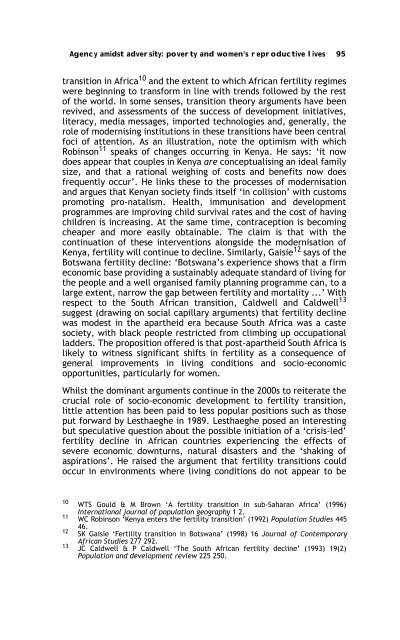Sex, Gender, Becoming - PULP
Sex, Gender, Becoming - PULP
Sex, Gender, Becoming - PULP
You also want an ePaper? Increase the reach of your titles
YUMPU automatically turns print PDFs into web optimized ePapers that Google loves.
Agency amidst adversity: poverty and women’s reproductive lives 95<br />
transition in Africa 10 and the extent to which African fertility regimes<br />
were beginning to transform in line with trends followed by the rest<br />
of the world. In some senses, transition theory arguments have been<br />
revived, and assessments of the success of development initiatives,<br />
literacy, media messages, imported technologies and, generally, the<br />
role of modernising institutions in these transitions have been central<br />
foci of attention. As an illustration, note the optimism with which<br />
Robinson 11 speaks of changes occurring in Kenya. He says: ‘it now<br />
does appear that couples in Kenya are conceptualising an ideal family<br />
size, and that a rational weighing of costs and benefits now does<br />
frequently occur’. He links these to the processes of modernisation<br />
and argues that Kenyan society finds itself ‘in collision’ with customs<br />
promoting pro-natalism. Health, immunisation and development<br />
programmes are improving child survival rates and the cost of having<br />
children is increasing. At the same time, contraception is becoming<br />
cheaper and more easily obtainable. The claim is that with the<br />
continuation of these interventions alongside the modernisation of<br />
Kenya, fertility will continue to decline. Similarly, Gaisie 12 says of the<br />
Botswana fertility decline: ‘Botswana’s experience shows that a firm<br />
economic base providing a sustainably adequate standard of living for<br />
the people and a well organised family planning programme can, to a<br />
large extent, narrow the gap between fertility and mortality ...’ With<br />
respect to the South African transition, Caldwell and Caldwell 13<br />
suggest (drawing on social capillary arguments) that fertility decline<br />
was modest in the apartheid era because South Africa was a caste<br />
society, with black people restricted from climbing up occupational<br />
ladders. The proposition offered is that post-apartheid South Africa is<br />
likely to witness significant shifts in fertility as a consequence of<br />
general improvements in living conditions and socio-economic<br />
opportunities, particularly for women.<br />
Whilst the dominant arguments continue in the 2000s to reiterate the<br />
crucial role of socio-economic development to fertility transition,<br />
little attention has been paid to less popular positions such as those<br />
put forward by Lesthaeghe in 1989. Lesthaeghe posed an interesting<br />
but speculative question about the possible initiation of a ‘crisis-led’<br />
fertility decline in African countries experiencing the effects of<br />
severe economic downturns, natural disasters and the ‘shaking of<br />
aspirations’. He raised the argument that fertility transitions could<br />
occur in environments where living conditions do not appear to be<br />
10<br />
WTS Gould & M Brown ‘A fertility transition in sub-Saharan Africa’ (1996)<br />
11<br />
International journal of population geography 1 2.<br />
WC Robinson ‘Kenya enters the fertility transition’ (1992) Population Studies 445<br />
12<br />
46.<br />
SK Gaisie ‘Fertility transition in Botswana’ (1998) 16 Journal of Contemporary<br />
13<br />
African Studies 277 292.<br />
JC Caldwell & P Caldwell ‘The South African fertility decline’ (1993) 19(2)<br />
Population and development review 225 250.
















